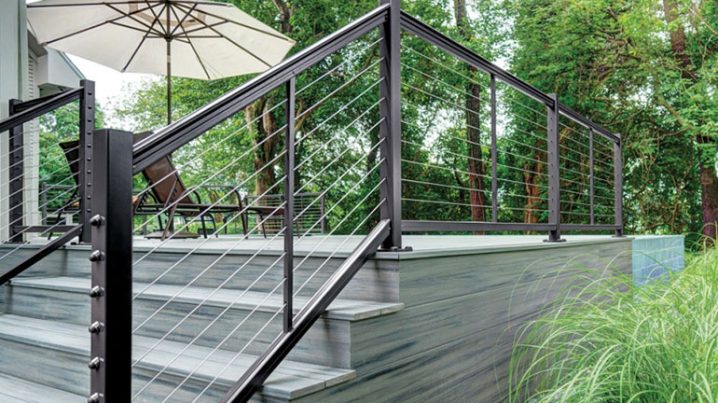When looking to beautify your interior or outside space, there are many options to choose from. But have you thought about using cable rails to produce a gorgeous view of your deck? Or perhaps you like to enhance the interior look with beautiful stair railings.
Cheap and ordinary railings can make a space or area seem more closed off from the rest of your home, creating a visual barrier, which is definitely not the case with cable rails. Cable rail consists of a series of metal wires that run horizontally between rail posts. As such, the system allows for a stunning open view while maintaining superior ventilation thus creating an industrial aesthetic that complements a contemporary style house.

Benefits of Cable Railing Systems
- Preserving Your View – Cable railings are great for terraces because their layout permits you an obstructed view.
- High durability and low maintenance – Cable rail is a slick solution which needs very little maintenance since all you’ve got to do is wipe. Furthermore, quality railings can withstand harsh weather and use along with being rust resistant. They’re also able to stand up to enormous pressure without breaking up.
- Added Value – Cable railing will add significant value to your home when it comes to selling.
- Increased Safety – Railings improve the protection of risk-prone areas like high stairs and decks. But you need to make certain they are of very good quality.
Horizontal vs. Vertical Cable Railing
Vertical railings are made from steel cables that are tightly pulled between the top and bottom rails. The rails themselves are typically made from powder-coated iron and are usually colored black to complement the modern look of the home.
However, most businesses and homeowners have preference for the horizontal cable railing configuration, which are modern deck railing designs in the market today and consists of rails running alongside the deck. So, what exactly makes horizontal cable railings more attractive than vertical railings?
Cost
Horizontal cable rail is inherently less costly than vertical rail. That is because it needs fewer substances to develop and install. Furthermore, in addition, it needs fewer connections, thereby cutting down the quantity of hardware needed.
Ease of Installation
As you want fewer substances for the setup, the practice is, thus, a great deal less laborious when compared with vertical rail. This also leads to the reduced costs connected with flat railing.
Versatility
You’ve got a larger collection of substances you could utilize in this configuration in comparison with vertical rail. This permits you a greater level of flexibility in layout.
Enhanced Feeling of Security without Compromising View
Horizontal railings enable you the exact same sense of security and openness that’s feature of wire railings without compromising your perspective. There’s still sufficient spacing between the cables to supply you with a wonderful view of your surroundings.
Aluminum vs. Steel Cable Railings
Metal cable railings are flexible and available in a variety of colours and designs. Metal railings are often powder-coated to make sure their sheen lasts years without needing to dedicate to maintenance. Metal railings, nevertheless, are two principal types: Aluminum and Steel.
While both metals are excellent choices, it is important to know their relative strengths and weaknesses to help you make the right choice. Let us consider these variables:
Durability
Stainless steel cable rails are famous for their durability and durability from the harshest weather conditions, making them very well known in areas with heavy snow or underfloor heating and will last for a lifetime. However, stainless steel is more vulnerable to rust that won’t just alter the way it seems, but in addition its structural integrity. Aluminum, though less hard when compared with stainless steel, includes superior powder coating that makes it quite resistant to rust.
Maintenance
Remember the powder coating we just mentioned above? That makes aluminum railings to be almost maintenance-free. You’ll just need to hose them down from time to time. Other than that, they do not need extra care to maintain their beauty or strength. Steel, however, requires regular care to ensure it does not rust. You may also have to repaint it every other year.
Cost
Aluminum is easier on the pocket than steel.
Installation
Steel is more challenging to install as it’s fairly heavy. Aluminum cable railing is lightweight, hence making it much easier to transfer, cut, and set up. As mentioned previously, cable rail usually runs between places. While the cable rails themselves are typically made out of metal, their posts can either be wooden or metallic. Which post type is good for you? Let’s compare.
Cable Railing Posts: Wood vs. Metal
Wood posts have a warm and inviting appearance but might have a limited lifespan. Nonetheless, the type of wood used is what determines the longevity of your railings. As compared to metal posts, wood can be cheaper. But in the long run, metal posts will prove cost-effective as they will not require replacement. Wood will add to the uniqueness of your décor, but metal will offer you more versatility.
While steel posts do look elegant, using metal in both railings and posts can become monotonous and, therefore, using wood is an excellent way of breaking that monotony.
Also, wood usually stays cool during hot weather, unlike metal that gets hot when it comes into contact with direct sunlight.
Cable railing installation is a fairly simple installation process and has a good number of options available to you for customization to achieve the look you desire. One well known California-based cable railing company, Feeney Inc., provides premium quality kits using the top grade T316 wire. The Feeney cable rail systems are excellent for coastal areas and harsh climates and are extremely beautiful in addition to being unobtrusive.



